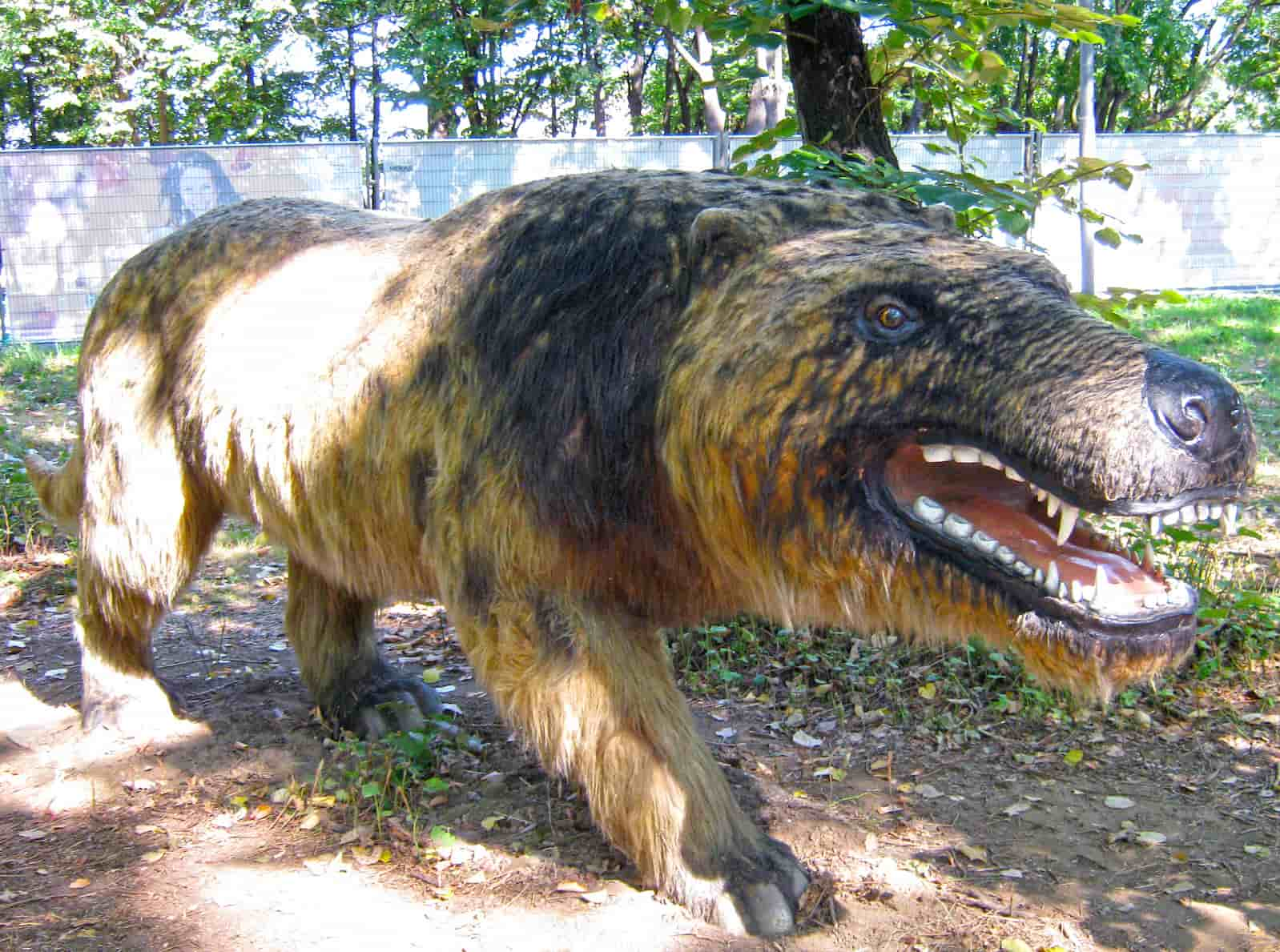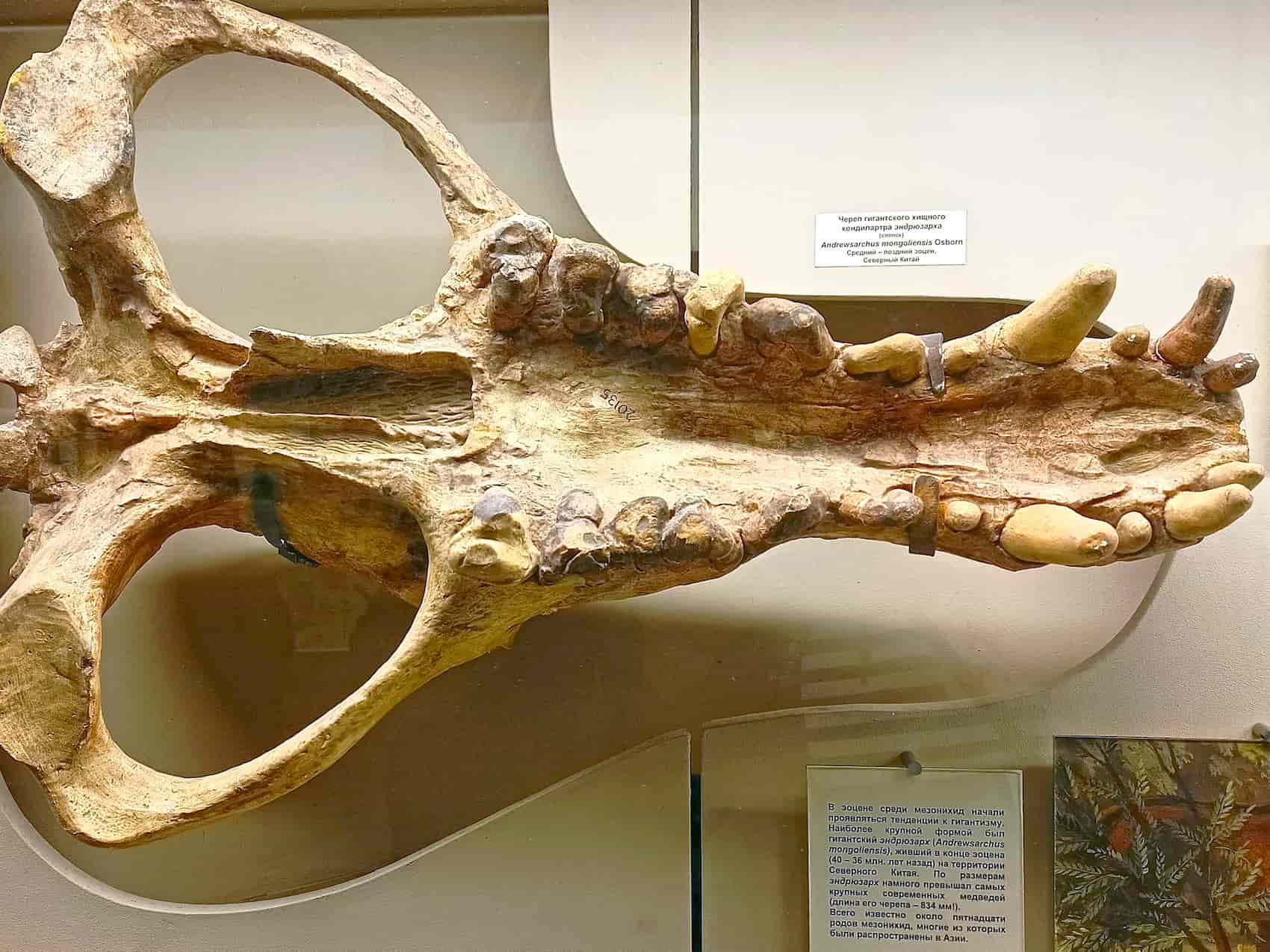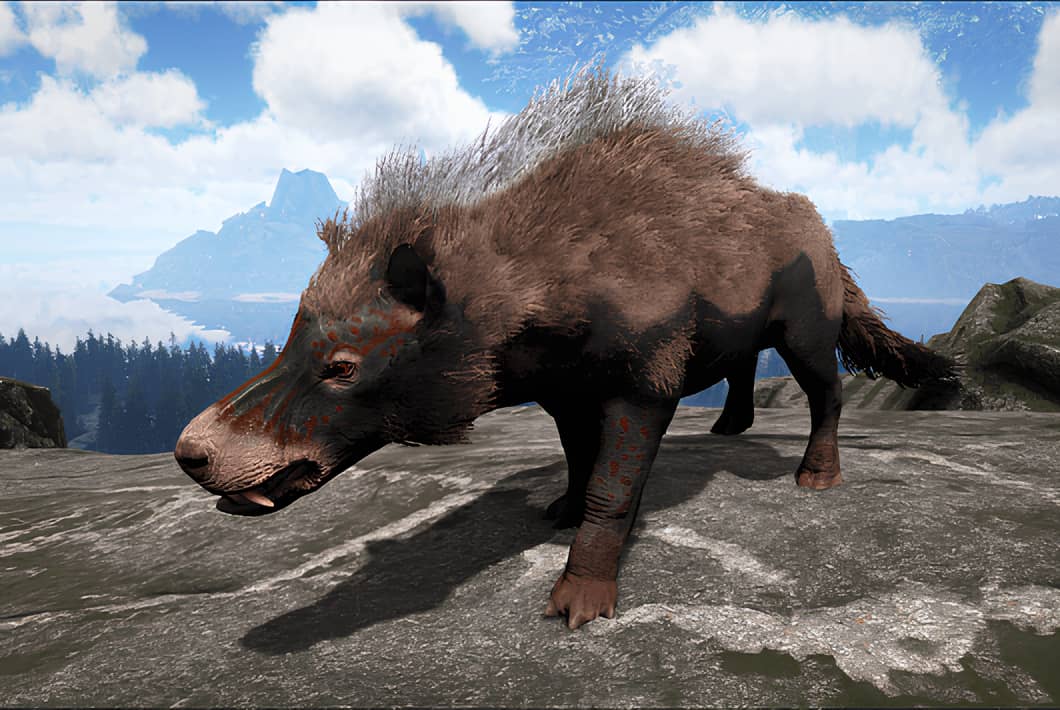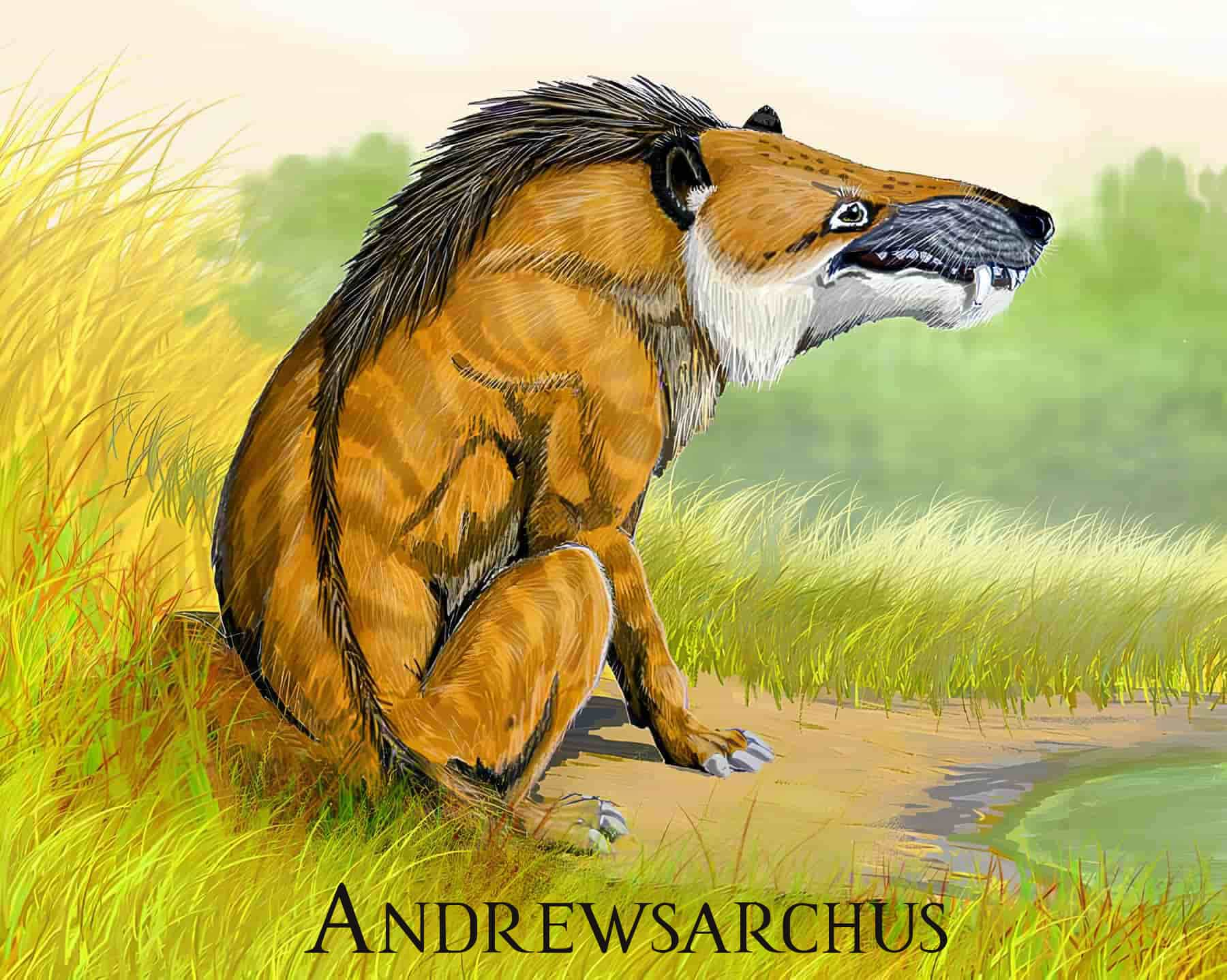- Andrewsarchus has one of the largest jaws of any land carnivorous mammal known to date.
- It has an elongated snout, measuring approximately 20 inches.
- This animal was one of the biggest known predatory land mammals, with a length between 150–180 inches, and 2,000 lb of weight.
Extinct huge carnivorous animals known as Andrewsarchus (Andrewsarchus mongoliensis) formerly roamed Central Asia (Inner Mongolia, China) during the Middle Eocene over 41 million years ago. It is known only from a complete skull from Inner Mongolia, where it was discovered in 1923. Originally identified as the largest representative of the Mesonyhids, the systematic position of Andrewsarchus is not clear today, but a close relationship with the cloven-hoofed animals is assumed.
Two Distinctive Features

One distinctive feature of this prehistoric mammal was the elongated snout, which measured a good 20 inches from the position of the first incisor to the posterior molar, while the posterior skull was correspondingly short and had only around 70% of the length of the snout. Another distinctive feature of this mammal is that it has one of the largest jaws of any land carnivorous mammal known to date.
The Andrewsarchus was called a “sheep in wolf clothing” in the BBC program Walking with Beasts due to its proximity to ungulates and its potential predatory nature. In this program, it was reconstructed to look like a giant hyena with hooves. This is based on the assumption that this species was not very agile due to its huge body size and that it fed mainly on slow-moving prey and carcasses.

It belongs to the order Mesonychia and the family Triisodontidae. These creatures are primordial ungulates, meaning they still have their original five- or four-toed limbs with hooves on the ends.
Andrewsarchus is the sole member of its genus.
The Meaning Behind the Naming
The name of this genus comes from the Greek term for “chief,” “leader,” and “regal,” (άρχος or archos) and the surname of the expedition commander, Roy Chapman Andrews. The species name “mongoliensis” for this species honors Inner Mongolia, the location where the fossils were discovered.
Discovery of the Andrewsarchus

In 1924, Henry Osborn wrote a description of Andrewsarchus based on a single, roughly 33-inch-long skull that Roy Chapman Andrews (1884–1960) discovered in Inner Mongolia. An assistant paleontologist named Kan Chuen Pao discovered the skull in the spring of 1923 in the Eocene deposits of the Irdin Manha Formation, which dates back to the late middle Eocene. Also, a sarkastodon bone was found in the same place.
This skull was discovered during the Third Central Asiatic Expedition of the American Museum of Natural History in the Inner Mongolian part of the Gobi Desert. The skull was found by expedition member George Olsen in the Erlian Basin. It was located in the Irdin-Manha Formation, a rock formation with more than 200 inches of grayish-white to grayish-yellow sandstones and sandy gravels, as well as numerous cylindrical calcareous concretions. The formation dates to the Middle Eocene, 46 to 40 million years ago, which gives a clue to the age of Andrewsarchus.
The skull can be inspected right now at New York’s American Museum of Natural History.

What Did Andrewsarchus Look Like?
2,000 Pounds of Weight
Andrewsarchus is one of the biggest known predatory land mammals (the polar bear is now the greatest land predator). The skull measured 32.8 inches in length (the greatest length of a contemporary brown bear’s head is 22 inches) and 22 inches in width at the zygomatic arches. Thus, the skull is about twice the size of an adult grizzly bear.
Reconstructions put the whole length of the Andrewsarchus at about 150 inches; other calculations put it at around 180 inches, including a tail that might be as long as 60 inches. Andrewsarchus might reach up to 63 inches in height at the withers. 2,000 pounds of weight was possible for this big predatory land mammal.
Strong Bites and Enormous Fangs
The animal’s large nose and broad zygomatic arches contributed to its low head. Large canines and incisors were paired with blunt molars. The brain cavity was tiny, as it usually is in most mesonychids. At the same time, the mandibular condyle was placed low, the temporal foramen was broad, and there was a prominent sagittal crest.

In English, all of these point to the existence of a well-developed temporal muscle and a strong bite in Andrewsarchus. If the size of the dental alveoli or the sockets in the jaws is any indication, Henry Osborn’s original description of the species draws attention to the “enormous size” of the fangs of the Andrewsarchus. Since the initial reconstruction of Andrewsarchus relied on a comparison to a smaller mesonychid, Synoplotherium (Dromocyon), it resembled a wolf and had relatively long legs and an extended skull.
The reconstruction was based on the fact that this mammal was long thought to be a close cousin of predators belonging to the group Mesonychidae, which were mostly rebuilt as wolf-like creatures despite having emerged much before the advent of actual wolves.
Long Torso, Small Legs, and a Huge Head
The current conception of Andrewsarchus posits that it had a long torso, small legs, and an extended, disproportionately huge head. In accordance with the nature of the mesonychids for which skeletons are available, the Andrewsarchus is often represented as toe-walking, resting on four toes. It’s possible that, like ancient Mesonychids, it still had five toes on each paw. Similar to other mesonychids, it probably had hooves on each toe. Its limbs ended in split phalanges, similar to those found in condylarth mammals.
Habits and Behaviour of Andrewsarchus
Wide Variety of Foods
The details regarding the daily existence of this prehistoric animal are mostly unknown. The animal’s low sagittal crest and tuberous cheek teeth indicate its ability to eat a wide variety of foods. Its premolar teeth measured 2.3 inches while the biggest molar was 2.6 inches wide.
Carnivorous Diet

Additionally, their packed row of teeth could grind through bone. The Andrewsarchus’ large pharynx and fang-like second set of incisors point to its carnivorous diet. The incisors likely improved the animal’s grip on the skin, making it easier to break off chunks of meat.
The structure of the jaw joint enabled this prehistoric animal to extend its mouth widely, exposing the cheek teeth for grabbing huge prey. The muzzles (snouts) of highly specialized predators like this are often shorter, and they have fewer teeth overall than those of generalist predators.
An Adapted Scavenger
Because of its enormous size, the animal was unusual in its movements. The short, somewhat obliquely oriented eyes, the long, narrow face, and the relatively deep nasal depression all suggest that Andrewsarchus may have been an adapted scavenger. Apparently, it could also scare away lesser predators (such as the huge bear-sized Harpagolestes mesonychid) from its prey. Andrewsarchus may also be capable of hunting live prey.
A Semi-Aquatic Animal
Its large head suggests it may have had a semi-aquatic existence and eaten fish (similar to other reptiles that do so, such as crocodiles, gharials, and phytosaurus). The rounded shape of the cheek teeth, however, refutes the theory of a fish-only diet.
One cannot rule out the possibility of Andrewsarchus meeting on the shores, where it gathered up washed-up carrion or possibly hunted small animals. However, present paleontological concepts suggest that the known areas of findings in the Eocene were relatively distant from the seas; therefore, it is plausible that the beast’s habitat was on the seashores.
A diet that included carrion, young, and small animals, as well as scaring away smaller predators from its prey, suggests that Andrewsarchus was an omnivore like contemporary bears. The skull, which is similar in form to the skulls of entelodonts, suggests as much.
Categorizing the Andrewsarchus

Formerly classified with the family Mesonychidae or the family Arctocyonidae, Andrewsarchus is now the only member of its own family, Andrewsarchidae.
The systematic position of Andrewsarchus, a genus of ancient mammals, remains uncertain. Initially thought to be a huge porcupine of the Entelodon genus, it was later considered a mesonychid, related to Mesonyx and Harpalogestes. Mesonychids, extinct ungulates from the Paleogene of North America and Asia, were primarily carnivorous or omnivorous with five-toed limbs.
Modern studies propose the classification of Andrewsarchus in Cetartiodactyla, although their exact placement is debated, either as a stem group or in Cetancodontamorpha.
Andrewsarchus, once in the Triisodontidae family, is now seen as a sister taxon to even-toed ungulates, closely related to entelodonts, whales, hippos, and certain anthracotheres. Only one established species, Andrewsarchus mongoliensis, exists; reports suggest two more species, A. crassum and Paratriisodon henanensis, though the latter’s classification is uncertain.
Fragmentary remains of Andrewsarchus found in China indicate its presence in Dongjun, Hetaoyuan, and Lushi. There is still debate about whether Andrewsarchus crassum is a separate species. In 1959, a piece from the Lushi Formation in Henan Province, China, was used to describe a possible synonym called Paratriisodon.
In Popular Culture

- Walking with Beasts, a 2001 TV series, prominently featured Andrewsarchus, although in its antiquated mesonychid form.
- Andrewsarchus is also featured in popular a video game called ARK: Survival Evolved (2015).


